Remembering Tony Candido
POSTED ON: November 3, 2023

Anthony Candido at a desk crit with Aimee Bida, a third-year architecture student, Spring 1992.*
Tony Candido’s colleagues, friends, and former students reflect on his singular trajectory within the disciplines of art and architecture and the immeasurable wisdom and guidance he imparted on those he encountered throughout his life.
Toshiko Mori—I was very lucky to have had an opportunity to teach with Tony. He was an honest and clear critic who had the capacity to see into the true state of students’ thoughts. He had an uncanny ability to observe and bring about the essence of everything. The morning of the day he died, I happened to bring out a painting of his that he had given me. I noted that there were no false notes and every stroke was in the right place, balancing each other, black and white. Tony must have been trying to tell me something: that he was crossing over, but do not forget.
I have fond memories of traveling with Tony and his wife Nancy to Asahikawa, Japan in the eighties. Nancy presented a dance performance and Tony gave a calligraphic painting demonstration. As he always did with Nancy’s performances, he designed the stage set and costumes. I remember many fantastic performances of their collaborative work at St. Mark’s Church in-the-Bowery. I was in Asahikawa again this past June and Tony’s calligraphy is still prominently displayed in the lobby of the biggest and most sustainable furniture company in Hokkaido. It was a lot of fun traveling with Tony in Japan because I think he has the soul of a Japanese sage.
Tony was one of four young architects that IM Pei invited to New York when he started his office. The others were John Hejduk, Harry Cobb, and Ulrich Franzen. Later he joined Davis Brody and worked on US Pavilion for Expo ’70, which had the most innovative membrane roof and became the genesis for the largest manufacturer of membrane structures in the world. Tony always directed us with his wisdom, and whomever he touched aspired to achieve greatness. I often ask myself "what would Tony say?" and remember his sobering, uncompromising vision and his wonderful smile. I will miss him greatly.
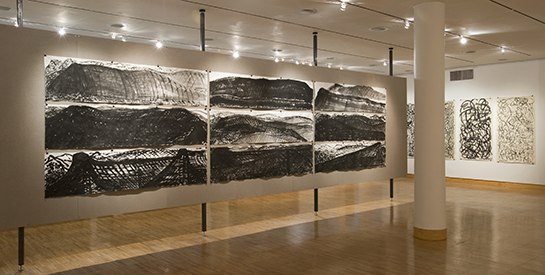
David Gersten—
There's so much in one's mind, so much in that repository. It all goes into the hopper, and the hopper is endless, bottomless. Sometimes, when I'm working, these images pop up. I may not realize it at first, but they're there. —Tony Candido
This short fragment offers a glimpse of Tony Candido’s depth and directness. Tony was many things: a painter, an architect, a searcher from The Bronx… He was a fighter pilot in World War II who then studied architecture with Mies van der Rohe in Chicago, and went on to be a magnificent teacher for decades in The Cooper Union’s School of Architecture, where I had the great honor of being his student and his teaching colleague. Tony was a rigorous pragmatist, especially when it came to mining the depths of the spirit. He was endlessly curious about the ineffable workings of the soul as they played out in substance and space—see his Night Paintings.
Tony and John Hejduk met working at IM Pei’s office in the mid-1950s, when they were both in their late twenties. Soon after, Tony began teaching architecture at The Cooper Union and, in fact, Tony was the person who went to Esmond Shaw, then assistant dean of the School of Art and Architecture, and told him he had to meet this guy named John Hejduk. As John said of Tony, “Real knows real, and there’s not a bumble bee around that could get that guy to drop his bone of conscience.”
Tony Candido’s direct depth was no swimming pool, it was an ocean 100 years deep—
his ‘Great White Whale is Black’—and all of us are better people for his friendship, work, and teaching.
Sue Ferguson Gussow—Anthony Candido, a man of depth, complexity, contradiction. A bomber pilot. A devout Buddhist. A man of many words—or very few. Eloquent and blunt. “You should meet Tony Candido,” Bob Slutzky said to me. “He’s an interesting painter.” Interesting he was, indeed. On my first studio visit, he was painting a series of nude crouching men. Himself. The colors were dark, moody, boldly brushed. What difficult postures to assume, I thought. Not possible to keep for long. How could he paint them, crouched like that? Of course, these were paintings of the mind as well as observation. Marks made from observation and memory both, quickly and raw, with authority.
Reminiscing about him recently, Beth Sigler AR’94 said, “… I adored Tony Candido.” Timing a live model’s pose, he had cautioned her, “You have two more minutes to ruin that!” “I learned to step back, to regard my work, to consider what I was doing…” she recalled. He would stop by her desk, ready to engage with whatever she might be doing—discussing a piece of paper from her papermaking class, for instance. She felt his support, his kindness.
I often went to performances staged by the dancer and choreographer Nancy Meehan, Tony’s beloved wife. They were also performances of Tony’s art. They were his bold brush work in motion. The calligraphic marks on the company’s costumes, designed and painted by Tony himself, were danced in space to Nancy’s choreography and Eleanor Hovda’s music. Tony’s collaborative costume art was Action Painting in its truest sense. However, unlike Action Painting’s credo of non-representation, Tony’s paintings held narratives. He had much to say. He told it as he saw it. He told it like it was.
Kyna Leski—Anthony Candido was my first studio professor at The Cooper Union. The projects he gave shaped my understanding of architecture and pedagogy. I remember being at my desk and suddenly realizing that he was standing next to me as I worked. His presence disappeared into saying what was necessary to induce contemplative practice.
It started like this: “2 posts (8” x 8” square; 12’ long). Span them. Brace them.”
At first, I contemplated (and tackled) a structural problem. Then I contemplated a construction problem. I contemplated form. When one spans and braces two posts, there is a portal: a here and a there and a through. That was when I understood, for the first time, what architecture is. I’ve returned to that moment throughout my education and my career, carrying forth these lessons.
Stephen Rustow—Tony Candido was more or less responsible for my teaching career at Cooper.
In the spring of 2003, I was among a group of invited jurors to the Third Year final review. We were in the lobby, arrayed in front of the long wall densely hung with drawings, and Tony was in the last seat on the right, saying nothing, but concentrating intently on the commentary. About halfway through the afternoon, just before a break, he suddenly turned towards me and said, “Hey you, kid—you teaching somewhere?” It took a moment to realize the question was addressed to me—it had been a long while since anyone had called me ‘kid’—and I answered no, I was practicing full time. “You wanna teach here?” he continued; I mumbled something about what a privilege that would be, still not sure if I was being led on. “I’ll talk to the Dean” he concluded. Three months later I got a message from Tony Vidler saying I should give him a call.
In the two decades of teaching that began that fall, I taught with Tony four or five times, often in Third Year, which I had been asked to coordinate and revamp to integrate questions of structure, materials, and methods using a typological approach to tie together analysis in the fall and design in the spring. Tony was a splendid colleague and even though he had taught that very course on and off for over thirty years, he was invariably encouraging, and very exacting, in our attempts to give it a new focus.
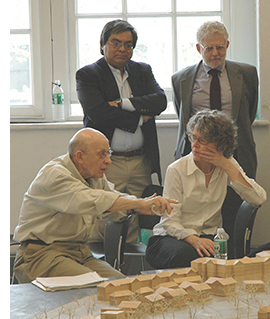
We occasionally did desk crits together and I quickly learned that he called lots of people ‘kid’—an age difference of ten years seemed to be the cut-off, which cast Tony himself in the role of the wise elder, one he played with great relish. He was a deeply perceptive critic, who expressed observations of great subtlety with an unerring directness. Indeed, Tony had a kind of plain-spoken gruffness that could intimidate students and colleagues alike, until gradually one came to understand it as a kind of performance that hid a shyness and fundamental sweetness he chose, for whatever reasons, not to show directly. He was also mildly hard of hearing, an affliction the severity of which seemed to vary in direct proportion to what he actually thought of whatever you had just said. If Tony repeated twice, “I didn’t get what you just said,” it was a sure sign that you might want to rethink your comment or reframe your question, or refrain from asking it at all.
Wonderfully opinionated yet perennially open to new ideas, tough in his expectations but invariably encouraging of younger colleagues and students alike, and sweeter than he would have liked any of us to know, Tony carried his contradictions with grace and great charm. The school had already felt his absence these last years; we won’t see his like again.
Mersiha Veledar—I am deeply saddened by the loss of Tony Candido, a former professor, colleague, inspiring mentor, and friend. Tony instilled excellence and love for architecture and the built environment. His distinct New York tone reverberated throughout the studio walls upon his entry, as he led us to develop exquisitely detailed plans and sections for new urban farms and housing projects in Germany (an area he admittedly bombed while serving as a pilot in the 1940s), for the third year Building Integrated Studios he taught for decades at The Cooper Union.
Tony’s commitment to advancing the work of his students was matched by his bold humor. In our very first encounter in 2000, he jokingly shared an anecdote from his visit to an ear doctor earlier that day, “I was supposed to get two hearing aids this morning, Mersiha, but I only got one so I could still yell at you!”
As the initial impact of meeting him settled, I found that behind his unstifled honesty there was humbling richness, having led an extraordinary multifaceted life as a brilliant educator, a practicing architect, a World War II pilot, a painter, and a surreal modern dance costume designer. The thick ink brushstrokes in his monolithic paintings paralleled the ethereal movement of dancers through the air—a study that arose from the deep love for the work of his late wife Nancy, who I had the privilege of knowing during the years of our friendship. Tony will be sorely missed and dearly remembered.
Kevin Bone—I met Anthony Candido in 1985. I had just joined the faculty at Cooper Union. Candido was part of the era’s incredible assemblage of educators: architects, artists, poets, and scholars from all walks of life, joined in one of the great experiments in architectural education.
Candido and his frequent teaching colleague, Richard Henderson, taught the analysis program. Analysis was an anchor studio where seminal works of architecture, from all ages and all places, were examined with fresh eyes. The student analyses of these works were themselves inspired artistic accomplishments. Students didn’t replicate a known understanding of architectural works. Under Candido’s guidance, they found their way to a personal understanding of the architecture. This was very much an artist’s approach to scholarship. Candido was a master of the process of acquiring knowledge through experiencing the accidental because that's how he painted. He would paint, look, respond, move on; his goal was not imagistic—it was to be alert to possibility.
I had the privilege of joining the Henderson and Candido studio in the 1990s. Every day was a chance to engage with this special world. By the late 1990s, Tony and I had partnered in various design studios. Starting in 1999 we did a series of studios called the Urban Farm. I loved this problem, and many people assumed it was something I had pushed for, but it was initially Candido's idea. Tony's early architectural speculations often imagined megastructures engaging the landscape, where boundaries between building and natural features blurred. I remember well a student who had proposed a wonderful landscape of apple orchards along the Newtown Creek. It was while overseeing this project that we learned there was such a thing as the Newtown Pippin. We all acquired this knowledge through experiencing the accidental.
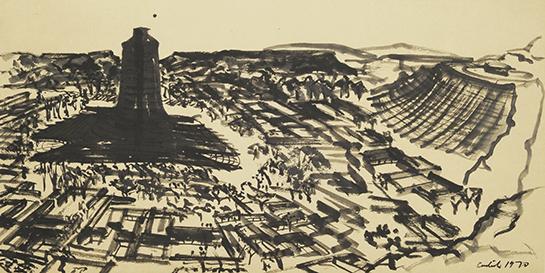
The last twenty years or so, after many, many years of working together, Tony and I became good friends. He also developed a wonderful relationship with my wife, Eugenia. I’m going to let her say a few words here.
You know how we choose families in life? Well Tony was my chosen Dad. I went to him for advice, usually wielding goodies from the Italian delis on Arthur Avenue in The Bronx where he was born. On one of my book tours, I was having a hard time feeling comfortable with my presentation, and I was experiencing a lot of self-doubt. I asked Tony “How do you handle self-doubt when you are at the lectern?” And he said “Gena, you just talk about what you know from your own experience. Nothing else matters. Then you’ll have no problem.” I have replayed that conversation, the cafe where we were, and how friggin’ hard it was to maneuver him into the booth, every single time I have spoken in public since.
Tony, and his wife Nancy Meehan, came over for dinners that were always filled with stories; decades worth of stories. At his 90th birthday he told us of the bombing raids on Dresden. Candido was in the Eighth Air Force, a mere boy of eighteen when he embarked on the most terrible of human undertakings: the conduct of war. He told the story with typically Candido levelness. It was what it was, he was doing what he was called upon to do, and he tried to learn from it all.
Every accidental experience, a chance for learning.
Tamar Zinguer—Being Professor Candido’s student felt like being on his team. He would call you by your last name, root for you from the sidelines, and, like a demanding coach offer “tough love.” A bit too tough, I told Tony years later, once we became colleagues. He didn’t believe me at first, but after checking with his wife Nancy, who concurred, he offered apologies. “No need!” I said. We all learned from him to be exacting in our arguments and drawings—no fashion or jargon allowed—while being as expressive as possible with any mark intimating space on paper. These were invaluable gifts. Thank you, Tony Candido, for your candor and friendship.
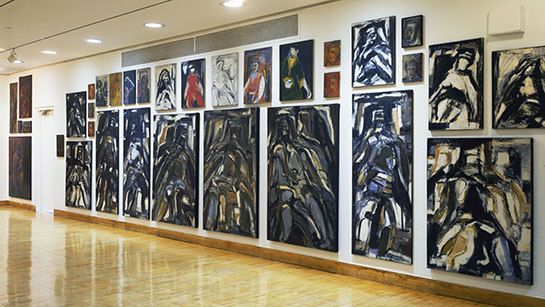
Anthony Titus—On a Sunday afternoon in May of 2006 while walking along the Fifth Avenue side of Central Park, my attention was captured by what appeared to be a long line of people stemming from the entrance of The Frick Collection. As I crossed the street to inquire about the purpose of the line, I discovered that a Francisco Goya exhibition was in its final hours. Recognizing the low likelihood of getting tickets at the last minute, I quickly brainstormed and proceeded to purchase the least expensive membership that would allow me and a guest access, without having to wait the long line. Immediately upon making the purchase, I called Tony and alerted him to the urgency of the situation, at which point he responded, “Give me five minutes and I’ll call you back.” Five minutes later my phone rang, and I was greeted on the other end with “I’ll hop in a taxi and see you there in 45 minutes.”
After his taxi arrived, we entered through the 70th street entrance and calmly made our way towards the exhibition. The show, titled Goya’s Last Works, was a beautiful cross section through some late career masterpieces by the artist. Prints, drawings, and paintings adorned the walls of the galleries, most of the works well known, some slightly more obscure, yet all captured the human condition in a way that seems to happen only once every few centuries. As Tony and I moved through many rooms, eventually nearing the end of the exhibition, we encountered a small wooden glass case which contained a half dozen miniature works of which were unfamiliar to us both. No bigger than postage stamps, these sensitive paintings made of black carbon and watercolor on ivory tablets depicted figures and heads which managed to capture the emotional depth of Goya’s large-scale black paintings which reside at the Prado Museum.
Painted between 1824 – 1825 as Goya neared his 80th birthday, these works seemed especially impressive due to the fact that his hearing and eyesight were all but gone by that stage in his life. As we turned away from the glass cases to exit the room, Tony turned to me and remarked: “Well kid, I’m glad I got to see this; it was certainly worth the ride up here. Seeing these small works is proof that seeing is not simply about the eyes—it’s in the mind and perhaps in other places that we’re probably not yet aware of.” As we exited the museum I was struck by Tony’s unique walk. There was a beauty in the way he would slowly and steadily put one foot in front of the other, as if he was confidently moving towards a future that may have only been fully visible to him.
The quintessential thinker-maker—in fact, there was no separation between these two acts for Tony Candido. His discipline and dedication to the arts of teaching, painting, and architecture remained at the core of his being and lasted to the very end of his life. At the age of 99, lucid in thought, memory, and intention, he worked as much as humanly possible, often spending long hours on concentrated sessions of drawing in small pads, using soft dark sticks of graphite. Over the last year of Tony’s life, I had the honor and pleasure of sharing several memorable calm and reflective conversations. Visiting him in hospital, and later in his home, he allowed me to look through the numerous drawings pads which he had been fastidiously working on over the course of his recovery. Meticulously constructed with layers of delicate graphite marks, the drawings captured the dense atmosphere of water and light that he and his beloved wife, dancer and choreographer Nancy Meehan, would experience on their many trips to Point Lobos and Big Sur in the early 1970s. On one recent Sunday afternoon visit as I carefully turned the pages of one of his many drawing pads, Tony explained that the fog and mist would sometime become so dense that they would be forced to stop the car, at which point Nancy would hop upon the hood (her feet resting on the bumper) while holding a flashlight to illuminate the nearly invisible road ahead. As Nancy would navigate, Tony would inch forward a few miles an hour until the fog would clear or their destination had been reached.
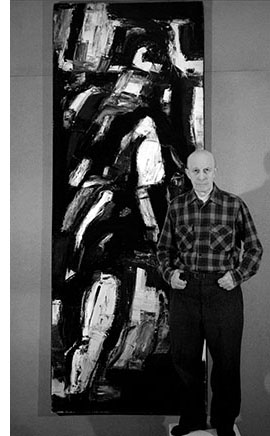
These late small delicate works on paper echo both the solidity of his Night Paintings of the late 1950s or the fluid line work of his monumental ink Heads of the late 1980s. To say that Anthony Candido will be missed is indeed a vast understatement. Tony’s presence loomed large in the lives of his many students and colleagues that he encountered over the six-decade span of his career as an educator. I feel a deep and profound sense of fortune to have been his student as well as having sustained a three-decade long friendship with him. Over that span of time Tony would generously share many memories, stories, and thoughts on the nature of life and art. A most sensitive and astute reader of poetry, literature, and philosophy, he had an ability to penetrate layers of complexity and arrive precisely at the core of a question. His love and knowledge of the writings of as Miguel De Unamuno and Paul Valéry as well as his passion for the music of Charlie Parker, Billie Holiday, and Lester ‘Pres’ Young (his favorite) are evident in the soulful depth of his drawings, paintings, and visionary architectural projects. I am fortunate to have known Tony as a teacher, mentor, and beloved friend. His humane spirit and principled mind will continue to reverberate in the lives of the many people he touched over his long and illustrious life.
*Photo credits: Photographer unknown, Anita Kan, Johan Elbers, Gina Pollara, Barb Choit, Liselot van der Heijden, Photographer unknown




